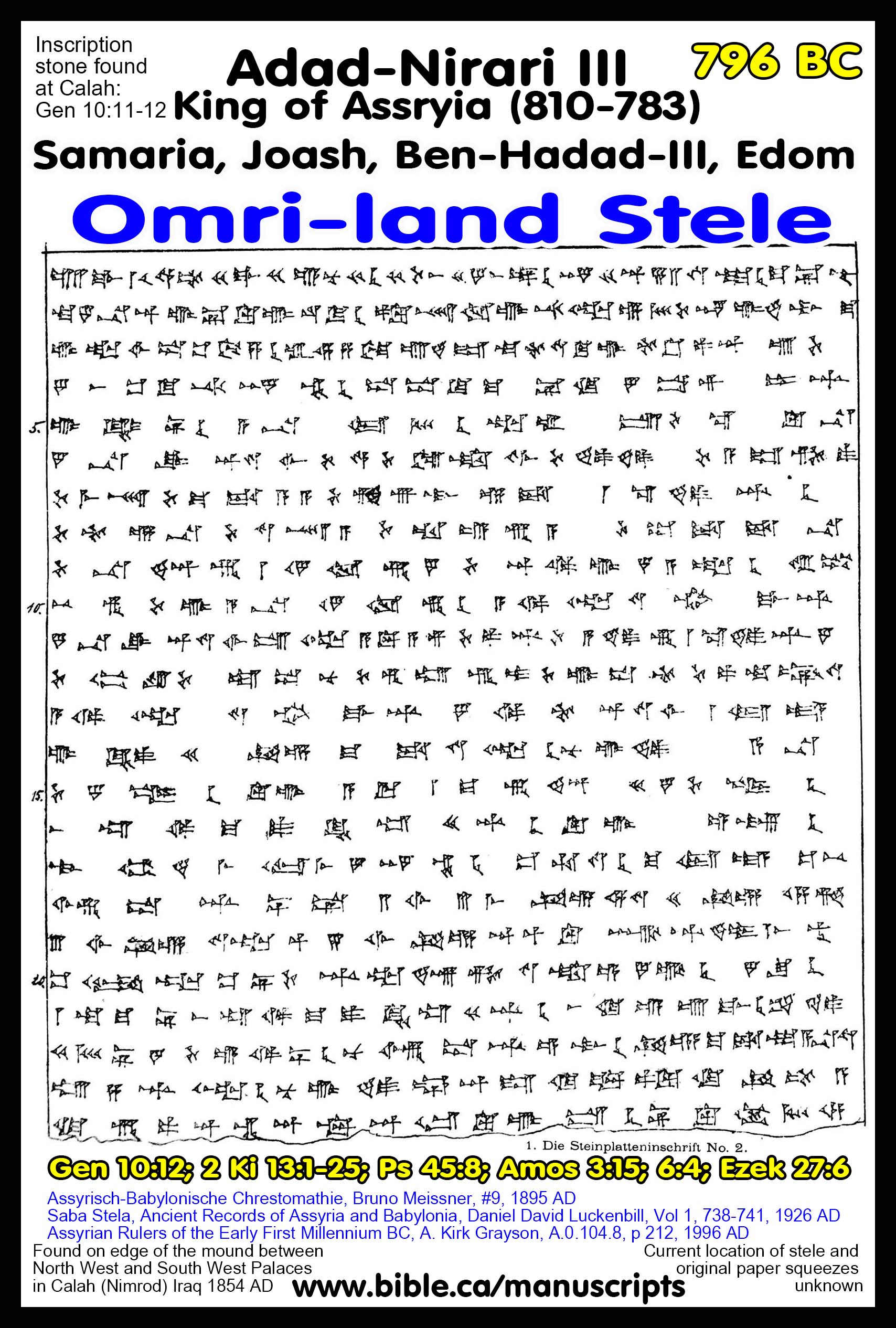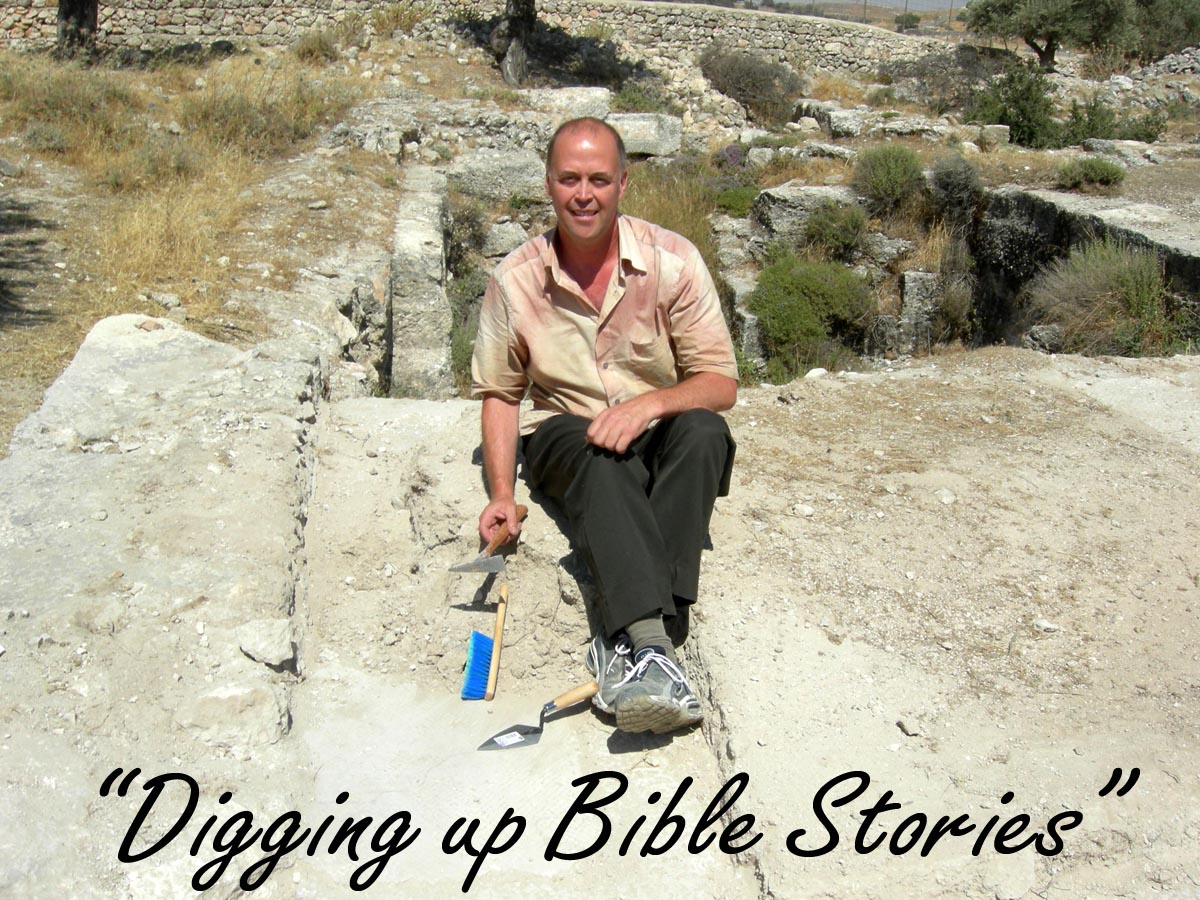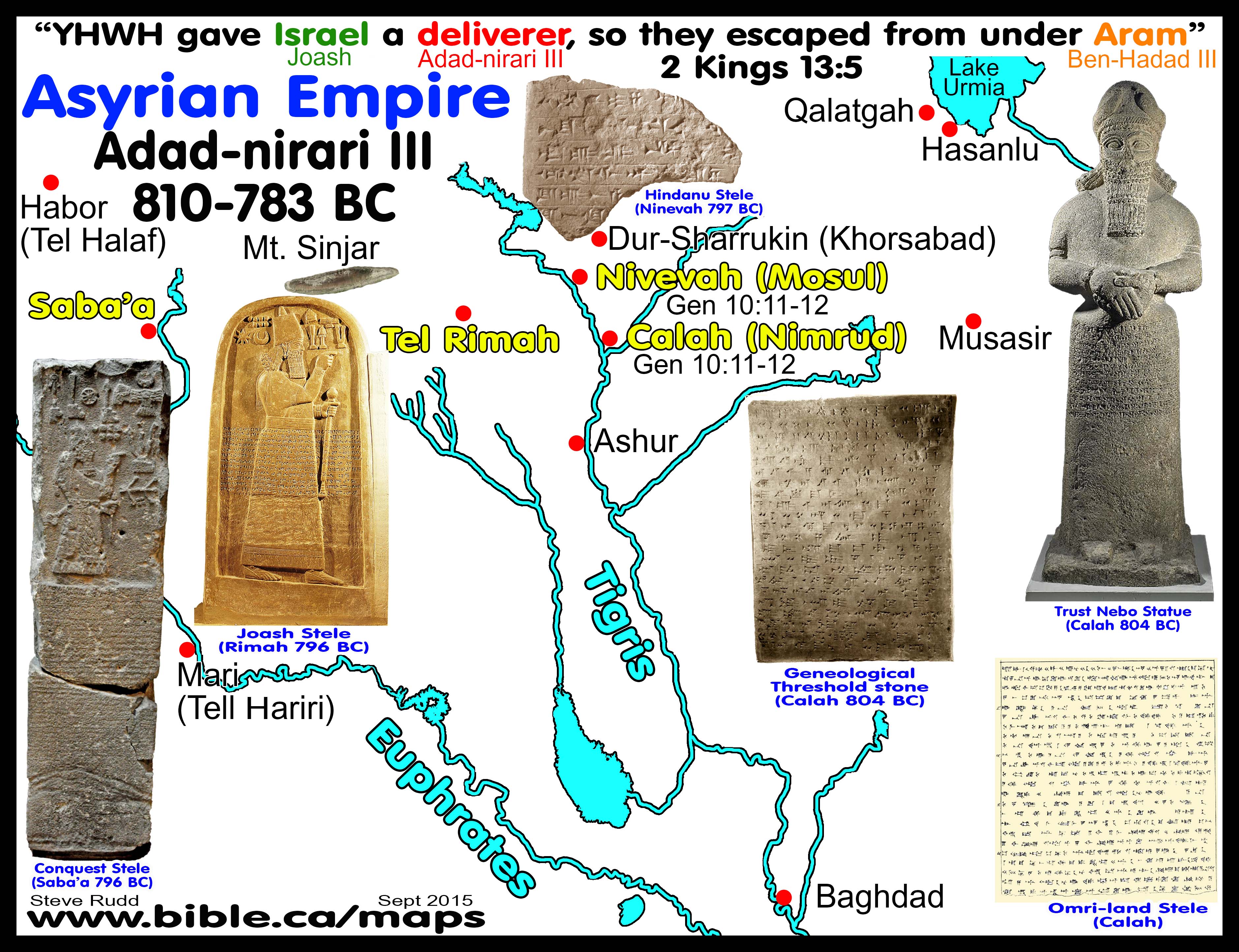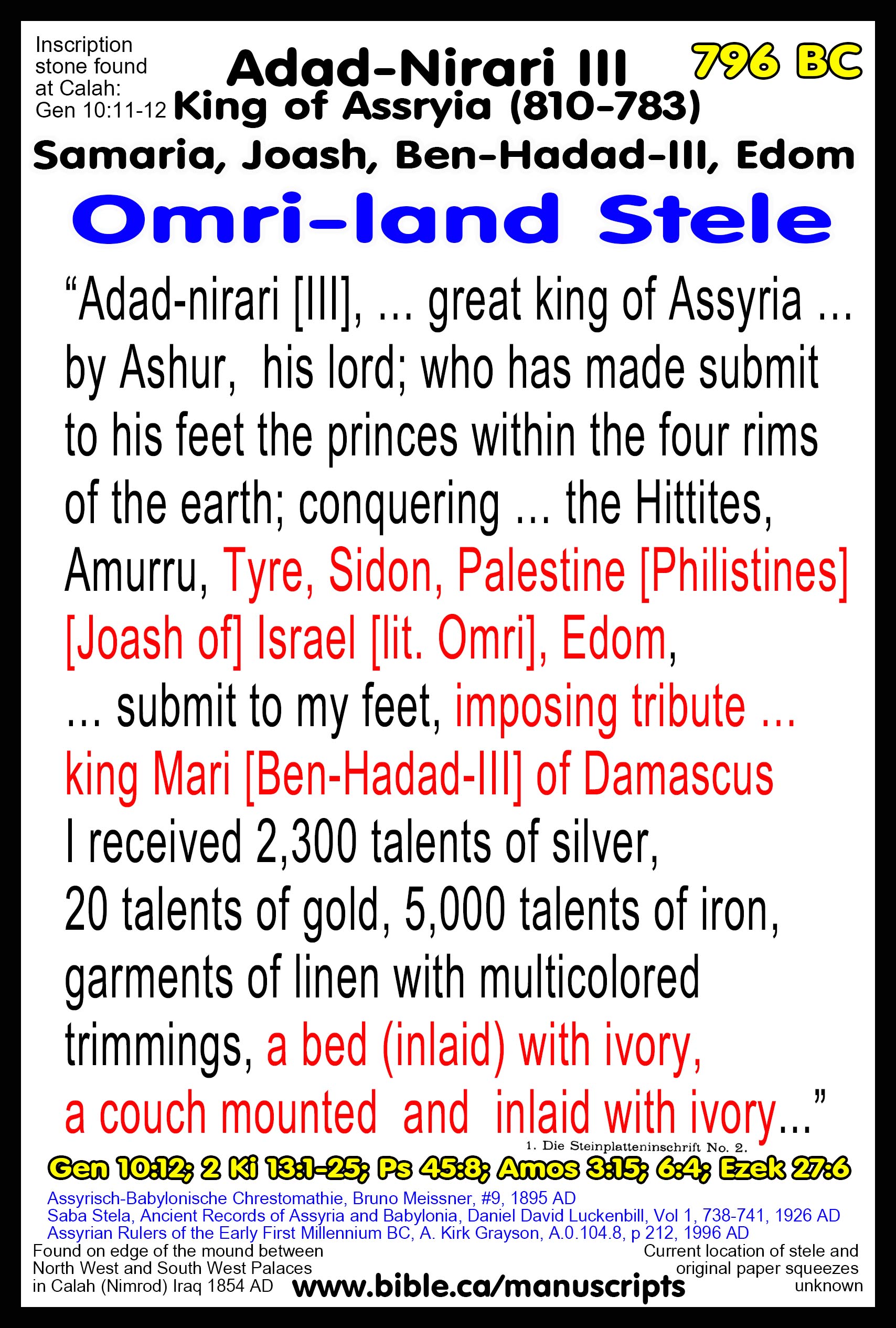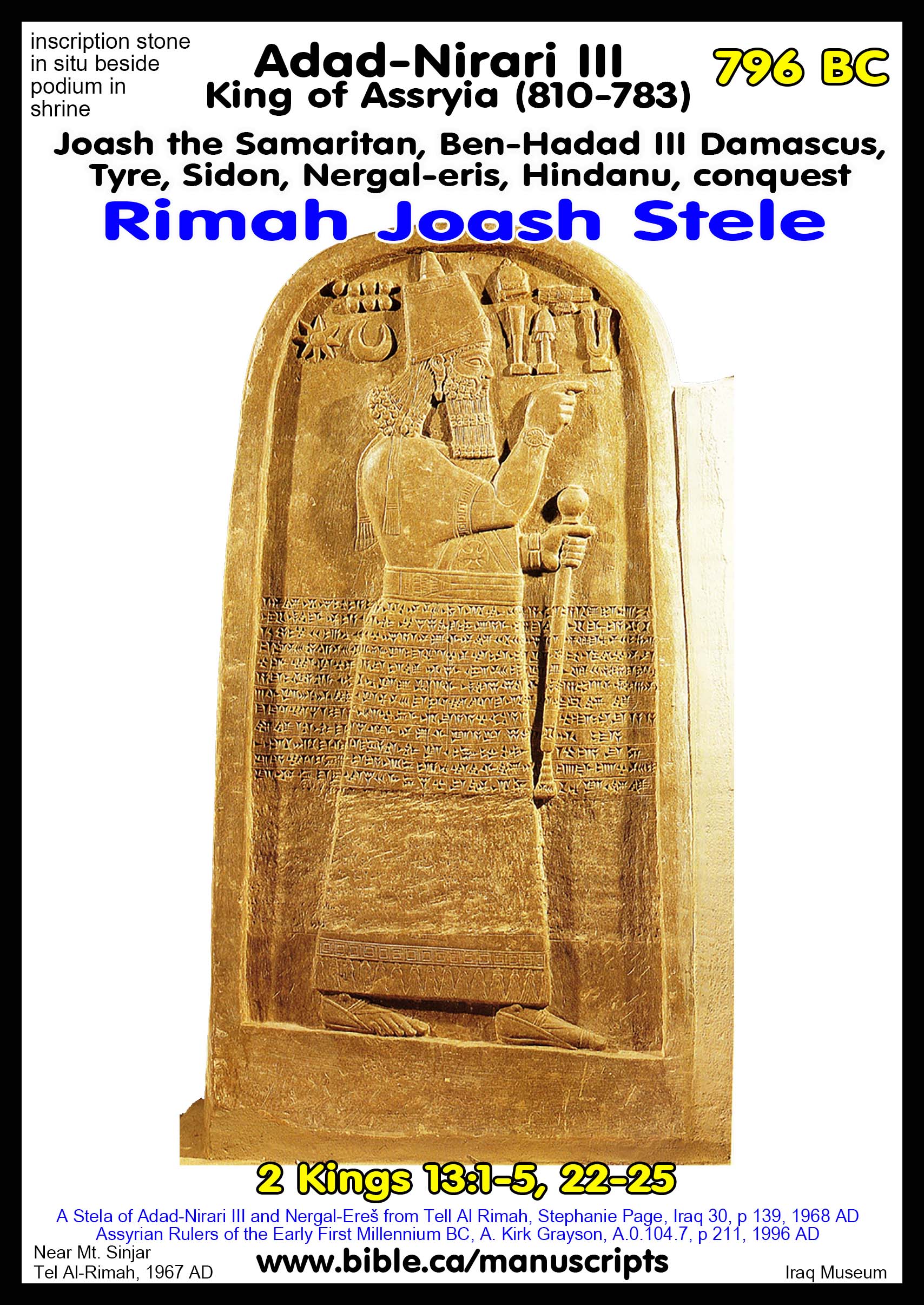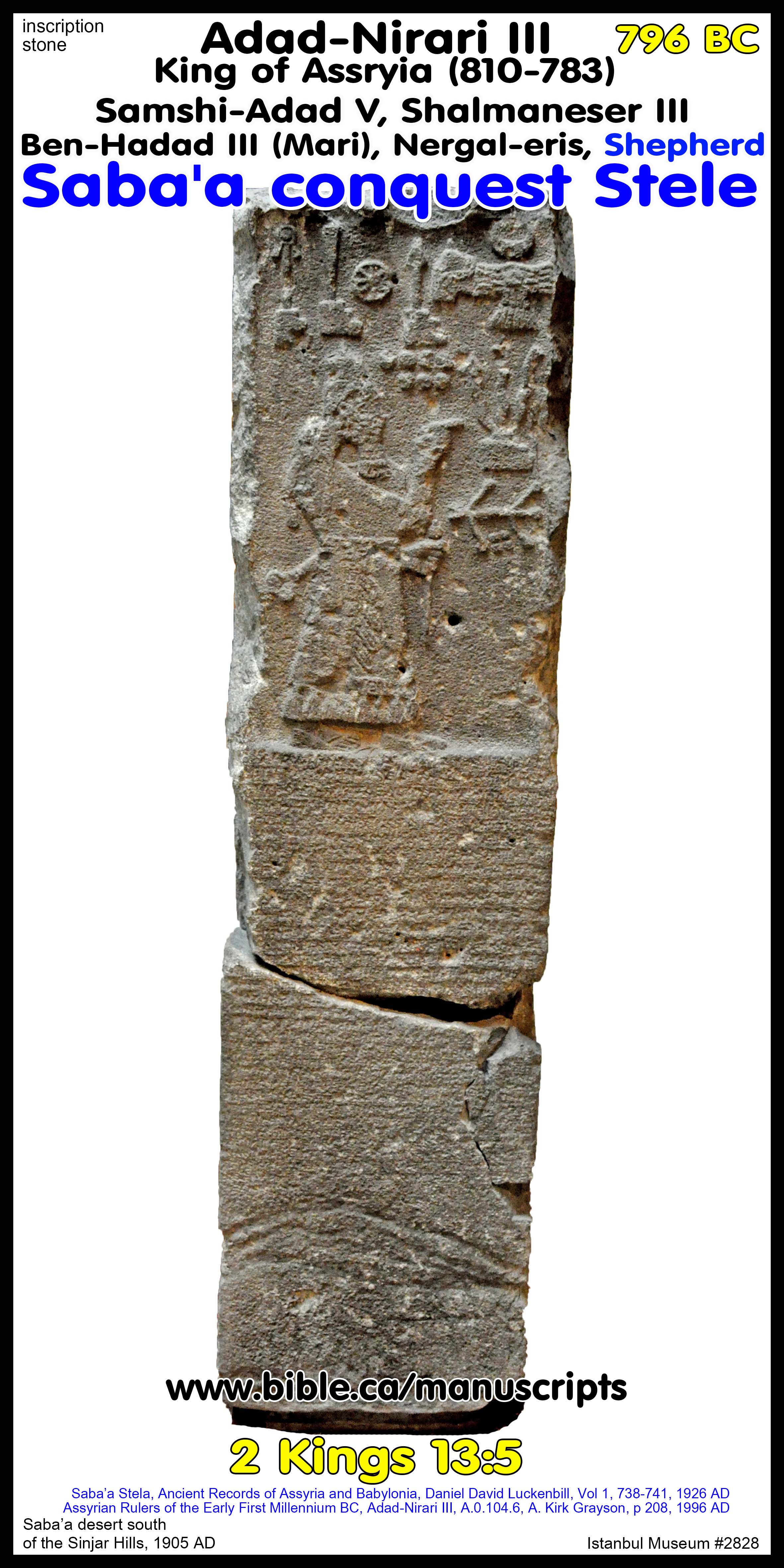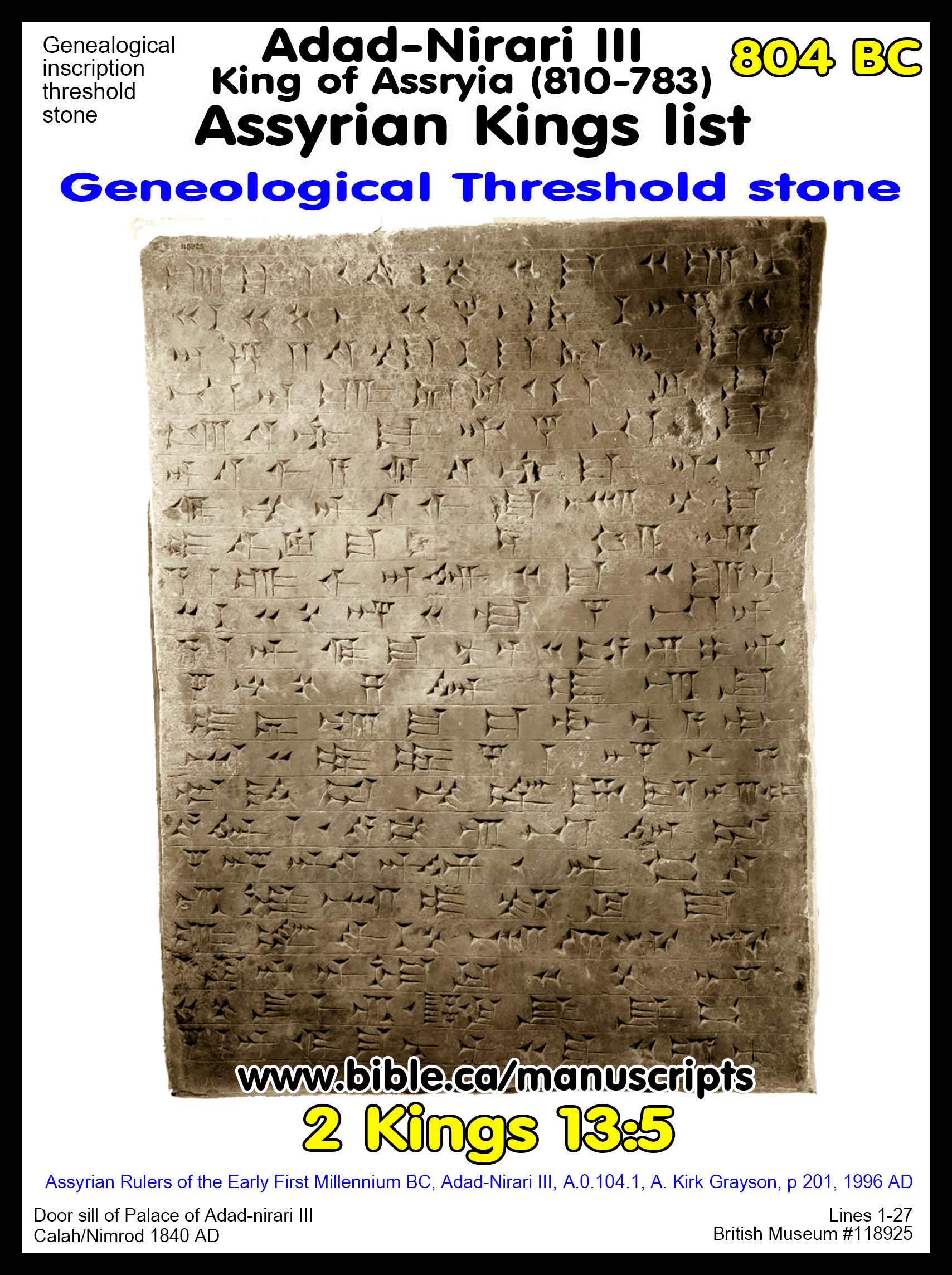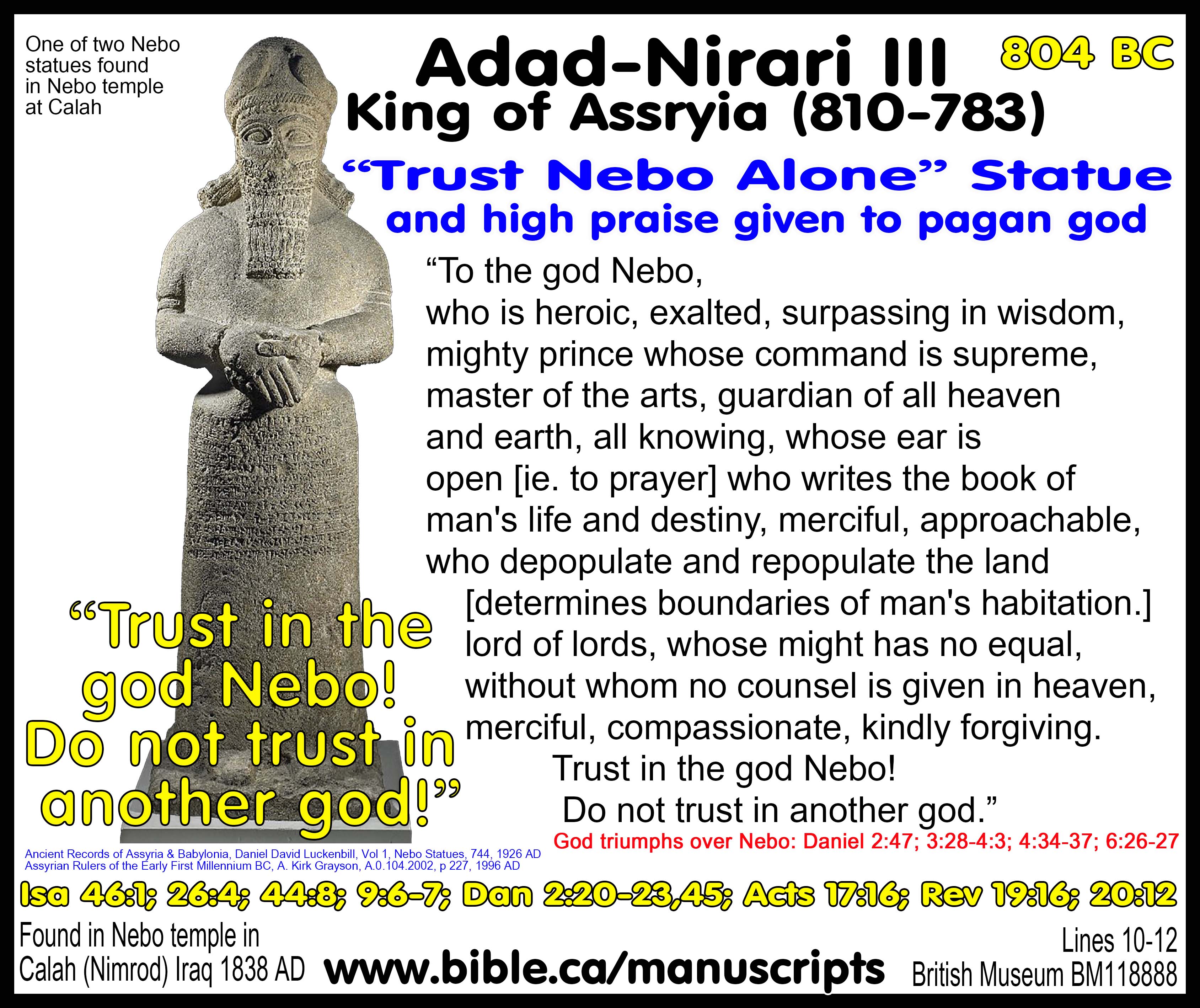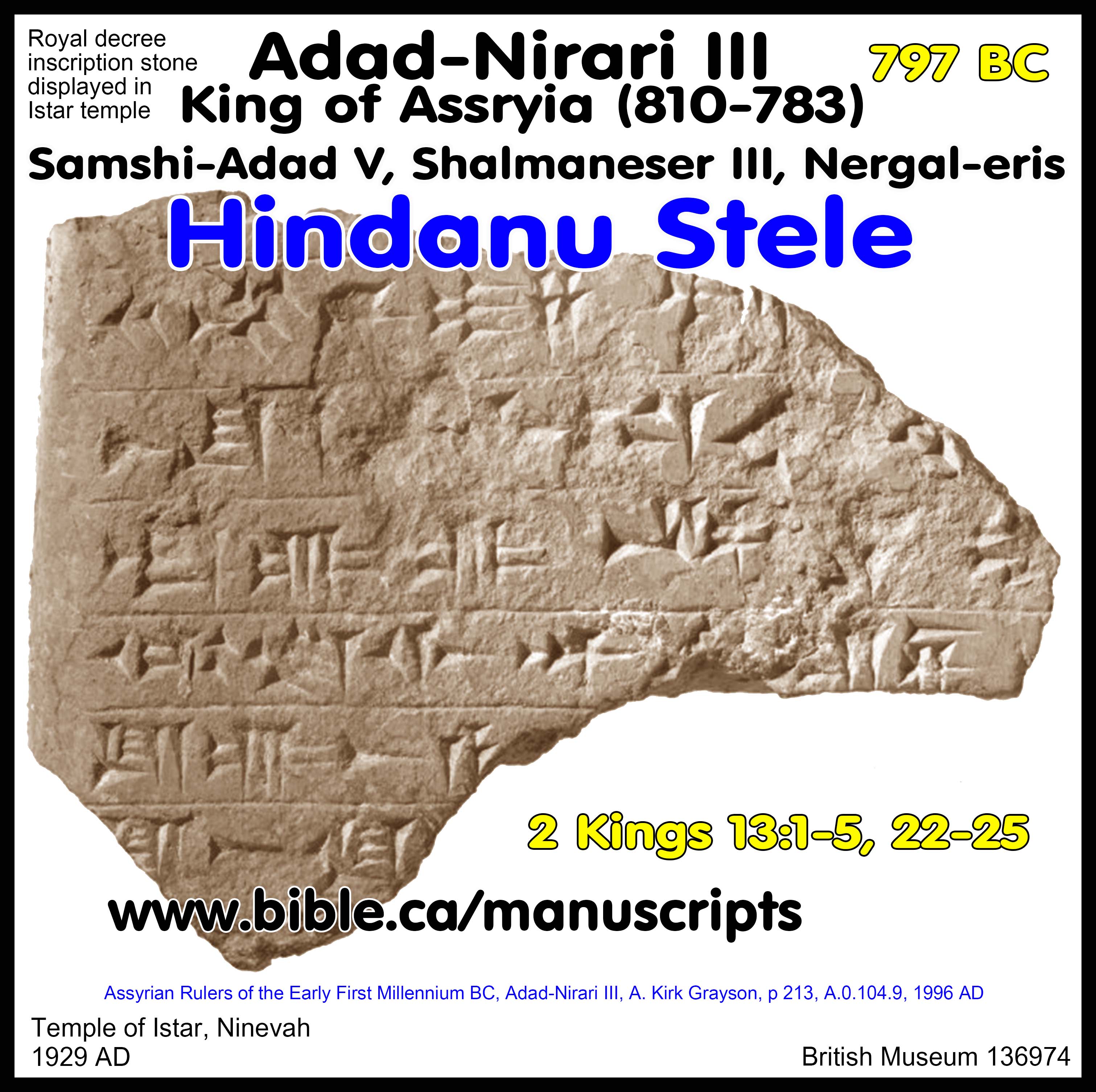Adad-Nirari III, King of Assyria (810-783)
"Omri-land Stela from Calah/Nimrod of Adad-nirari III"
|
Adad-Nirari III (810 - 783 BC) "The unknown deliverer" |
||
|
2 Kings 13:5 |
||
|
"YHWH gave Israel King Jehoahaz & Joash (Israel) |
a deliverer King Adad-nirari III (Assyria) |
they escaped Aram" King Ben Hadad III (Aram) |
Jehoash (Joash) of Israel [Omri-land], Ben-Hadad-III (Mari) king of Damascus
Inscription on Stone Slab found at Calah (Nimrod): 796 BC
"I received tribute from Tyre, Sidon, Israel (Omri-land), Edom, Philistines, and Damascus." (ANET, 282)
|
Omri Stela of Adad-nirari III 796 BC
“Adad-nirari [III], … great king of Assyria … by Ashur, his lord; who has made submit to his feet the princes within the four rims of the earth; conquering … the Hittites, Amurru, Tyre, Sidon, Palestine [Philistines] [Joash of] Israel [lit. Omri], Edom, … submit to my feet, imposing tribute … king Mari [Ben-Hadad-III] of Damascus I received 2,300 talents of silver, 20 talents of gold, 5,000 talents of iron, garments of linen with multicolored trimmings, a bed (inlaid) with ivory, a couch mounted and inlaid with ivory...” (Omri-land Stela from Calah/Nimrod of Adad-nirari III, 796 BC) |
|
Digging up Bible stories! The Omri-land conquest Stele confirms the story of where God delivered Israel out of the hand of Ben-Hadad III (son of Hazael), king of Aram in 2 Kings 13:5. God sent Israel (Jehoahaz and Joash, Samaria) a deliverer (Adad-nirari III, Assyria) they escaped Aram (Ben Hadad III, Aram) The Omri-stele also contains the earliest reference in Assyrian literature that mentions Edom. (see outline on Edom.) Detailed outline on Adad-Nirari III "What we read in the book, we find in the ground"
|
Introduction:
- This amazing stele of Adad-Nirari III (810-783) was written in 796 BC and found in Calah, modern day Iraq.
- It refers to Israel (ie the ten northern tribes) as "Omri-land", since Omri was the one who founded the city of Samaria and made it the capital city of "Israel".
3. Bible kings indirectly referenced in the stele include:
a. Jehoash (Joash) king of Israel/Samaria [Omri-land]
b. Ben-Hadad-III (Mari) king of Damascus
4. Inscription on Stone Slab found at Calah (Nimrod): 796 BC
a. Calah is one of four ancient cities founded by Nimrod (Nimrud)
b. "From that land he went forth into Assyria, and built Nineveh and Rehoboth-Ir and Calah, and Resen between Nineveh and Calah; that is the great city." (Genesis 10:11-12)
- Earliest Assyrian reference to "Edom" in the Omri-land stele: 796 BC
- See detailed outline on Edom
- Earlier references to Edom in archeology referred to Edom as "Kushu.
- "Local epigraphic data and Assyrian sources also suggest that the political development of Edom occurred no earlier than the eighth century B.C. The earliest reference to Edom in Assyrian inscriptions appears on the Nimrud Slab, a list of states subjugated by Adad-nirari III ca. 796 B.C. The next mention is a tribute list of Tiglath-pileser III that refers to events ca. 732 B.C. The list names the first known Edomite king, “Kaushmalaku of Edom [U-du-mu-a-a]”. From that time on, references to Edom, or Edomite kings, in Assyrian sources are usual. The earliest local epigraphic material that can be confidently dated is a royal seal impression from Umm el-Biyara referring to a personality that has been identified as “Qos-Gabr, King of Edom” (qws g[br]/mlk ’[dm]). This ruler is mentioned twice in Assyrian inscriptions from the reigns of Esarhaddon and Ashurbanipal, which date to ca. 670 B.C. While this seventh century B.C. impression only provides us with a terminus post quem for the site and its pottery, since Umm el-Biyara is essentially a one-period site, the date of the settlement cannot be too much earlier." (Journal of Hebrew Scriptures, Vol. 6, No. 56, p10, 2006 AD)
- Ben-hadad III king of Aram (son of Hazael) is named "Mari" in three stele of Adad-nirari III:
- "Mari" is a title of the kings of Aram applied to both Ben Hadad III on the Omri-land stele and his father of Hazael in other inscriptions.
- Detailed outline on Hazael, king of Aram and the "House of David" Stele found at tel Dan.
- This archeological object directly confirms a specific bible story where God sent Assyrian king Adad-Nirari III to deliver Israel from Ben-Hadad III (king of Arad at Damascus, son of Hazael) in 2 Kings 13:5.
- "So the anger of the Lord was kindled against Israel, and He gave them continually into the hand of Hazael king of Aram, and into the hand of Ben-hadad the son of Hazael. Then Jehoahaz entreated the favor of the Lord, and the Lord listened to him; for He saw the oppression of Israel, how the king of Aram oppressed them. The Lord gave Israel a deliverer [Adad-Nirari III], so that they escaped from under the hand of the Arameans; and the sons of Israel lived in their tents as formerly." (2 Kings 13:3–5)
- Hazael is the king who wrote the Tel
Dan Stele that lists 8 Bible kings and names. Ben-Hadad III was
Hazael's son! (note: Ben-Hadad II was succeeded by Hazael, the usurper.
Ben-Hadad III is the son of Hazael and is not on the Victory
stele of Hazael dating to 841 BC.
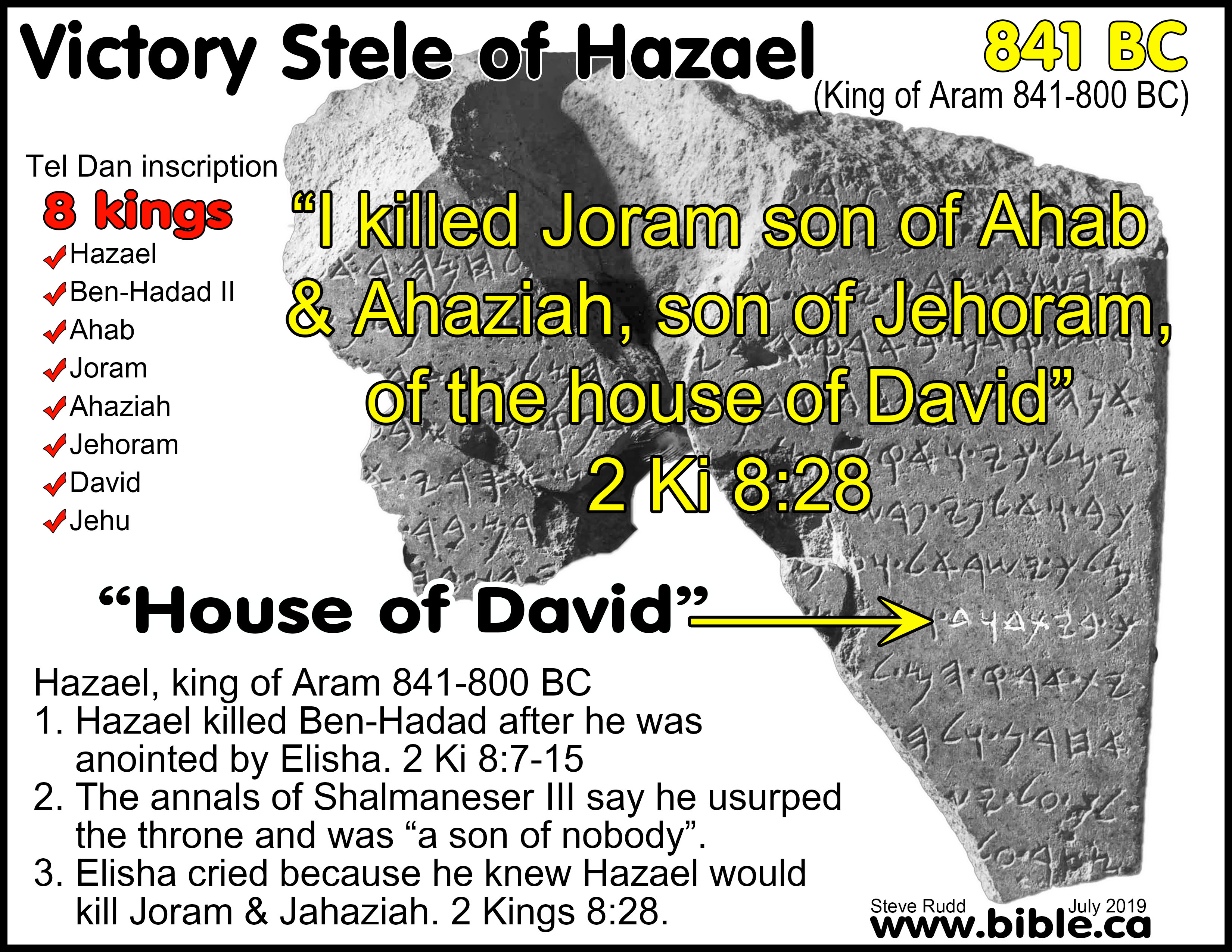
I. About the Omri-land stele of Adad-Nirari III:
- The stele has been lost and so have all the original pressed paper squeeze images. All we have are copies of the original paper mache impressions. The best copy is found in Assyrisch-Babylonische Chrestomathie, Bruno Meissner, #9, 1895 AD.
- "On the upper portion of a slab found at Nimrod (Calah) is engraved the better-known inscription of this king. The text was published in IR, Plate 35, No. x. According to the Index to the Kou-yunjik Catalogue, this slab is "not in Europe." (Nimrod Slab, Ancient Records of Assyria and Babylonia, Daniel David Luckenbill, Vol 1, 732, 1926 AD)
- "This text was inscribed on a broken stone slab found by Loftus in 1854 at Calah, at the edge of the mound between the North West and South West Palaces. It begins (lines 1-5a) with the royal name and epithets, but curiously lacks a genealogy. It then describes (lines 5b-14), in general geographic terms, the extent of Adad-narari III's conquests, going from east to west. It goes on to record two particular achievements, the submission of Damascus (lines 15-21) and the king's activities in Babylonia (lines 22-24). At this point the text breaks off. The location of the original broken slab is unknown and the text is known only from the published copy, which was based on paper squeezes which were subsequently destroyed (see Reade, ARRIM 4 [1986] p. 27)." (Assyrian Rulers of the Early First Millennium BC, Adad-Nirari III, Omri-land Calah/Nimrod Stele, A.0.104.8, A. Kirk Grayson, p 212, 1996 AD)
II. Bible story behind the Omri-land Stela of Adad-nirari III
- The wars between Joash, Damascus and Assyria: 2 Kings 13:1-5, 22-25
- "The Lord gave Israel a deliverer [Adad-Nirari III, king of Assyria], so that they escaped from under the hand of the Arameans; and the sons of Israel lived in their tents as formerly." (2 Kings 13:5)
- "In the twenty-third year of King Joash son of Ahaziah of Judah, Jehoahaz son of Jehu began to reign over Israel in Samaria; he reigned seventeen years. He did what was evil in the sight of the Lord, and followed the sins of Jeroboam son of Nebat, which he caused Israel to sin; he did not depart from them. The anger of the Lord was kindled against Israel, so that he gave them repeatedly into the hand of King Hazael of Aram, then into the hand of Ben-hadad son of Hazael. But Jehoahaz entreated the Lord, and the Lord heeded him; for he saw the oppression of Israel, how the king of Aram oppressed them. Therefore the Lord gave Israel a savior, so that they escaped from the hand of the Arameans; and the people of Israel lived in their homes as formerly." (2 Kings 13:1–5)
- "Now King Hazael of Aram oppressed Israel all the days of Jehoahaz. But the Lord was gracious to them and had compassion on them; he turned toward them, because of his covenant with Abraham, Isaac, and Jacob, and would not destroy them; nor has he banished them from his presence until now. When King Hazael of Aram died, his son Ben-hadad succeeded him. Then Jehoash son of Jehoahaz took again from Ben-hadad son of Hazael the towns that he had taken from his father Jehoahaz in war. Three times Joash defeated him and recovered the towns of Israel." (2 Kings 13:22–25)
- "King Jehoash of Israel captured King Amaziah of Judah son of Jehoash, son of Ahaziah, at Beth-shemesh; he came to Jerusalem, and broke down the wall of Jerusalem from the Ephraim Gate to the Corner Gate, a distance of four hundred cubits." (2 Kings 14:13)
III. The Bible's "ivory connection" with the Omri stele:
- Bible texts: Ps 45:8; Amos 3:15; 6:4; Ezek 27:6
- Samaria was a city founded by Omri as the new capital of the northern ten tribes of Israel.
- Excavations have found much ivory at the Israeli capital city of Samaria and Megiddo: Ps 45:8; Amos 3:15; 6:4; Ezek 27:6
- Solomon used ivory on his throne and in his palaces:
- "Moreover, the king made a great throne of ivory and overlaid it with refined gold." (1 Kings 10:18)
- "your robes are all fragrant with myrrh and aloes and cassia. From ivory palaces stringed instruments make you glad;" (Psalm 45:8)
- Samaria, the capital city of Israel founded by Omri, was famous for ivory:
- "I will tear down the winter house as well as the summer house; and the houses of ivory shall perish, and the great houses shall come to an end, says the Lord." (Amos 3:15)
- "Alas for those who lie on beds of ivory, and lounge on their couches, and eat lambs from the flock, and calves from the stall;" (Amos 6:4)
- Ivory was in use in Sept 587 at Tyre who traded ivory:
- "From oaks of Bashan they made your oars; they made your deck of pines from the coasts of Cyprus, inlaid with ivory." (Ezekiel 27:6)
- "The sons of Dedan were your traders. Many coastlands were your market; ivory tusks and ebony they brought as your payment." (Ezekiel 27:15)
IV. Translation of Omni-land Stele of Adad-Nirari III:
|
Omri Stela of Adad-nirari III 796 BC
“Adad-nirari [III], … great king of Assyria … by Ashur, his lord; who has made submit to his feet the princes within the four rims of the earth; conquering … the Hittites, Amurru, Tyre, Sidon, Palestine [Philistines] [Joash of] Israel [lit. Omri], Edom, … submit to my feet, imposing tribute … king Mari [Ben-Hadad-III] of Damascus I received 2,300 talents of silver, 20 talents of gold, 5,000 talents of iron, garments of linen with multicolored trimmings, a bed (inlaid) with ivory, a couch mounted and inlaid with ivory...” (Omri-land Stela from Calah/Nimrod of Adad-nirari III, 796 BC) |
- "(lines 1-5a) Palace of Adad-narari (III), great king, strong king, king of the universe, king of Assyria; the king in whose youth Assur, king of the Igigu gods, chose, entrusted him with unrivalled rulership, made his shepherdship pleasing like a healing drug to the people of Assyria, (and) established his throne; holy priest who unceasingly provides for Esarra (and) maintains the rites of Ekur, who campaigns with the support of Akur, his lord, and subdues the princes of the four quarters; (lines 5b-14) Conqueror from Mount Siluna in the east, the lands Namri, Ellipi, Harhar, Arazias, Mesu, Media, Gizilbunda in its entirety, Munna, Parsua, Allabria, Abdadanu, Nairi in its entirety, Andia, which is far away, Mount BADhu in its entirety, as far as the shore of the great sea in the east. I subdued (the territory stretching) from the bank of the Euphrates, the land Hatti, the land Amurru in its entirety, Tyre, Sidon, Samaria (Humri), Edom, (and) Palastu, as far as the great sea in the west. I imposed tax (and) tribute upon them. (lines 15-21) I marched to Damascus. Mari, king of Damascus, I confined in Damascus, his royal city. The awesome brilliance of Assur, my (text "his") lord, overwhelmed him, he submitted to me, and became my vassal. I received 2,300 talents of silver, 20 talents of gold, 3,000 talents of bronze, 5,000 talents of iron, linen garments with multi-coloured trim, an ivory bed, a couch with inlaid ivory, his property (and) possessions without number — (I received all of this) within his palace in Damascus, his royal city. (lines 22-24) All the kings of Chaldaea became my vassals (and) I imposed upon them in perpetuity tax (and) tribute. At Babylon, Borsippa, (and) Cuthah they delivered up the remnant offerings of the gods Bel, Nabu, (and) Nergal. [I made] pure sacrifices. … ['Lacuna' ie. Missing text]" (Assyrian Rulers of the Early First Millennium BC, Adad-Nirari III, Omri-land Calah/Nimrod Stele, A.0.104.8, A. Kirk Grayson, p 212, 1996 AD)
- "Palace of Adad-nirari, the great king, the mighty king, king of the universe, king of Assyria, the king whom Assur, king of the Igigi, called in his youth and gave him a kingdom without a rival; whose rule (lit., shepherding) he (Assur) made beneficial (lit., good) as the food (plant) of life for the people of Assyria, and whose throne he firmly established; holy priest, who provides magnificently for Esharra, who is unwearied, who upholds the cult (/it., law, com-mand) of Ekur (or, the temple); who went (forth) under the protection of Assur, his lord, and brought the princes of the four regions (of the world) in submission to his feet; who conquered from Mount Siluna of the east (rising sun), the lands of Saban(?), Ellipi, Harhar, Araziash, Mesu, Madai, Gizil-btmda in its totality, Munna, Parsua, Allabria, Abdadana, Nalri to its farthest border, Andiu, which lies afar off, the mountain slope(?) to its farthest border, up to the great sea of the rising sun ; from above the Euphrates,—Hatti, Amurru, in its totality, Tyre, Sidon, [ie. King Jehoash/Joash of ] Humri (lit: Omriland, ie. Israel), Edom, Palastu [ie Philistines], up to the great sea of the setting sun,—I brought (these lands) in submission to my feet. Tribute and tax I imposed upon them. Against Aram (Syria) I marched, Mari' [ie. Ben-Hadad-III], king of Aram,—in Damascus, his royal city, I shut him up. The terrifying splendor of Assur, his (prob. error for, my) lord, overwhelmed him and he laid hold of my feet, he became my vassal (lit., did my service). 2,3oo talents of silver, 20 talents of gold, 3,000 talents of copper, 5,000 talents of iron, colored woolen and linen garments, an ivory bed, an ivory couch, in-laid and bejeweled(?), his property and his goods, in immeasurable quantity, in Damascus, his royal city, in his palace, I received. The kings of Kaldu, all of them, became my vassals; tribute and tax for all time to come I imposed upon them. Babylon, Borsippa, Kutha, brought the "remnant" of Bel, Naba and Nergal, pure sacrifices…" (Saba Stela, Ancient Records of Assyria and Babylonia, Daniel David Luckenbill, Vol 1, 738-741, 1926 AD)
- "Property of Adad-nirari, great king, legitimate king, king of the world, king of Assyria—a king whom Ashur, the king of the Igigi (i.e. the dei superi) had chosen (already) when he was a youngster, entrusting him with the position of a prince without rival, (a king) whose shepherding they made as agreeable to the people of Assyria as (is the smell of) the Plant of Life, (a king) whose throne they established firmly; the holy high priest (and) tireless caretaker of the temple é. s á r. r a, who keeps up the rites of the sanctuary, who acts (only) upon the trust-inspiring oracles (given) by Ashur, his lord; who has made submit to his feet the princes within the four rims of the earth; conquering from the Siluna mountain of the Rising Sun, the countries Saban, Ellipi, Harhar, Araziash, Mesu, the (country of the) Medians, Gizilbunda in its (full) extent, the countries Munna, Persia (Parsua), Allabria, Apdadana, Na’iri with all its regions, Andiu which lies far away in the pitḫu of the mountains with all its regions, as far as the Great Sea of the Rising Sun (and) from the banks of the Euphrates, the country of the Hittites, Amurru-country in its full extent, Tyre, Sidon, [ie. Jehoash/Joash of] Israel (matḪu-um-ri, Lit: Omri-land), Edom, Palestine (Pa-la-as-tu. Ie. Philistines), as far as the shore of the Great Sea of the Setting Sun, I made them submit all to my feet, imposing upon them tribute. I marched against the country Ša-imērišu: I shut up Mari’ [ie. Ben-Hadad-III], king of Damascus (Imērišu) in Damascus (Di-ma-áš-qi), his royal residence. The terror-inspiring glamor of Ashur, my (text: his) lord, overwhelmed him and he seized my feet, assuming the position of a slave (of mine). (Then) I received in his (own) palace in Damascus (Di-ma-áš-qi), his royal residence, 2,300 talents of silver (corresponding to) 20 talents of gold, 5,000 talents of iron, garments of linen with multicolored trimmings, a bed (inlaid) with ivory, a nimattu-couch mounted and inlaid with ivory, (and) countless (other objects being) his possessions." (ANET, p 281)
- Cuneiform Inscriptions of Western Asia, H.C. Rawlinson, Bd. Vol 1, plate 35, No. 1, lines 1-21, 1861 AD
Conclusion:
1. This stele refers to Israel as "Omri-land"
a. Omri was the one who founded the city of Samaria and made it the capital city of "Israel"
b. "Omri-land" is how foreign kings referred to the ten northern tribes we call Israel!
2. The stele indirectly references these two Bible kings:
a. Jehoash (Joash) king of Israel
b. Ben-Hadad-III (Mari) king of Damascus
3. The Omri-stele also contains the earliest reference in Assyrian literature that mentions Edom. (see outline on Edom.)
4. Inscription on Stone Slab found at Calah (Nimrod): 796 BC Genesis 10:11-12
a. Calah was one of four great ancient cities of Assyria.
b. "From that land he went forth into Assyria, and built Nineveh and Rehoboth-Ir and Calah, and Resen between Nineveh and Calah; that is the great city." (Genesis 10:11–12)
5. What we read in the bible, we find in the ground! Find me a church to attend in my home town this Sunday!
|
2 Kings 13:5 |
||
|
"YHWH gave Israel King Jehoahaz & Joash (Israel) |
a deliverer King Adad-nirari III (Assyria) |
they escaped Aram" King Ben Hadad III (Aram) |
|
Conquest Stela of Adad-Nirari III (810 - 783 BC) Detailed outline on Adad-Nirari III . |
||
|
Religious and dynastic Stela of Adad-Nirari III (810 - 783 BC) |
||
By Steve Rudd: Contact the author for comments, input or corrections.
